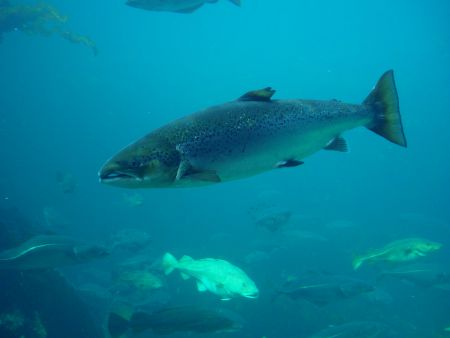KJIPUKTUK, HALIFAX - Atlantic salmon are sleek predators of the ocean. With a body designed for rapid acceleration, these fish can reach speeds of thirty kilometers an hour and surmount twelve foot obstacles. Atlantic salmon in the southern portion of eastern Canada are also critically threatened and despite conservation efforts, this population continues to decline.
Along the Bay of Fundy and Nova Scotia’s east coast, Atlantic salmon numbers are very low and the species is considered endangered. In the southern Gulf of St Lawrence and along the Gaspé Peninsula, numbers are a bit higher overall, since the mighty Miramichi River (New Brunswick coast) still hosts a salmon population several thousand strong. In Newfoundland, a population on the south coast is also considered threatened, although salmon numbers in the rest of the province are stable.
The decline of our Atlantic salmon dates back to the 1950s when an important ocean feeding ground for the Atlantic Canadian population was discovered near Greenland. New motorized trawlers were quick to exploit this rich find and by the 1980s, the Atlantic Canadian population collapsed under intensive fishing pressure.
Despite increasing conservation efforts since then, numbers of Atlantic salmon south of Newfoundland have continued to decline. On the Miramichi River, annual salmon numbers have dropped from 82,000 in the 1990s to 23,000 since 2011 and only 12,000 in 2014. Because Atlantic salmon raise their young in fresh waters and spend much of their adult lives in salty ones, the species can encounter a variety of threats during its lifespan.
Freshwater habitat can be degraded by soil erosion, pollution and the construction of dams that prevent salmon from migrating upstream. In recent years, organizations across Atlantic Canada have worked hard to improve freshwater habitat for salmon and all aquatic life. On Prince Edward Island, community watershed groups have collaborated with landowners to reduce soil erosion and re-establish natural vegetation along streams and rivers. In southern Nova Scotia, decades of acid rain has changed the pH levels in many rivers, causing salmon to disappear from more than a dozen of them. Now an innovative project is underway to add lime and restore the natural pH level in several of these rivers.
While much progress has been made in reversing impacts to our salmon’s fresh water habitat, the mortality of young salmon at sea has doubled since the 1970s and scientists are racing to figure out why. Currently, a major obstacle to juvenile salmon appears to be a rebounding striped bass population that scoops up young salmon as they enter river estuaries for the first time.
While serious international efforts are in place to prevent salmon from ending up as by-catch, fewer and fewer juveniles are surviving to return to their natal rivers. It appears that an Atlantic Ocean warmed by climate change may be the biggest obstacle we have created for Atlantic salmon. New predator species are following warming waters northward and adding to the pressure on young salmon. There is also evidence in Scotland that juvenile salmon are confused by changing water temperatures and currents. It hinders their sense of direction in a changing ocean.
So there is no easy answer to the decline of Atlantic salmon. Instead we have many threats that reinforce each other and prevent this species from recovering fully. Solving these problems will require a strong commitment from humanity and a multifaceted approach. Fortunately, addressing impacts to Atlantic salmon will benefit a host of other aquatic species and may in the end be good for humanity too.
Colin Jeffrey is a coordinator for the Sierra Club’s Blue Whale Campaign, an initiative to raise public awareness of threats to the Gulf of Saint Lawrence ecosystem and a call for sustainable management. To learn more about the campaign, visit atlantic.sierraclub.ca/protectthegulf or contact Jeffrey directly at colinjef@hotmail.com



